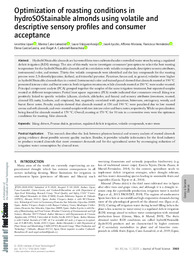Por favor, use este identificador para citar o enlazar este ítem:
https://hdl.handle.net/11000/35225Full metadata record
| DC Field | Value | Language |
|---|---|---|
| dc.contributor.author | Lipan, Leontina | - |
| dc.contributor.author | Cano-Lamadrid, Marina | - |
| dc.contributor.author | Vázquez-Aráujo, Laura | - |
| dc.contributor.author | Lyczko, Jacek | - |
| dc.contributor.author | Moriana, Alfonso | - |
| dc.contributor.author | Hernández, Francisca | - |
| dc.contributor.author | García García, Elena | - |
| dc.contributor.author | Carbonell-Barrachina, Ángel A. | - |
| dc.contributor.other | Departamentos de la UMH::Biología Aplicada | es_ES |
| dc.date.accessioned | 2025-01-24T07:59:04Z | - |
| dc.date.available | 2025-01-24T07:59:04Z | - |
| dc.date.created | 2020 | - |
| dc.identifier.citation | Journal of Food Science Vol. 85, Iss. 11, 2020 | es_ES |
| dc.identifier.issn | 1750-3841 | - |
| dc.identifier.issn | 0022-1147 | - |
| dc.identifier.uri | https://hdl.handle.net/11000/35225 | - |
| dc.description.abstract | HydroSOStainable almonds are harvested from trees cultivated under controlled water stress by using a regulated deficit irrigation (RDI) strategy. The aim of this study was to investigate consumers’ perception to select the best roasting temperature for the hydroSOStainable almonds and its correlation with volatile compounds, descriptive sensory attributes, instrumental color, and texture. Thirty-five volatile compounds were identified and the key compounds for the roasting process were 2,5-dimethylpyrazine, furfural, and trimethyl pyrazine. Pyrazines, furans and, in general, volatiles were higher in hydroSOStainable almonds than in control. Instrumental color and trained panel showed that almonds roasted at 190 °C presented intense color and burnt notes in both irrigation treatments,while almonds roasted at 150 °C were under-roasted. Principal component analysis (PCA) grouped together the samples of the same irrigation treatment, but separated samples roasted at different temperatures. Partial least square regression (PLS) results indicated that consumers overall liking was positively linked to specific volatiles (alkanes, alcohols, aldehydes, and furans) and sensory attributes (sweetness, roasted, almond ID, nutty, hardness, and crispiness), but, negatively correlated with pyrazines, bitterness, astringency, woody, and burnt flavor notes. Penalty analysis showed that almonds roasted at 150 and 190 °C were penalized due to low roasted aroma and soft almonds,and over-roasted samples with too intense color and burn notes, respectively.While no penalization being found for almonds roasted at 170 °C. Overall, roasting at 170 °C for 10 min in a convective oven were the optimum conditions for roasting Vairo almonds. | es_ES |
| dc.format | application/pdf | es_ES |
| dc.format.extent | 12 | es_ES |
| dc.language.iso | eng | es_ES |
| dc.publisher | Wiley | es_ES |
| dc.rights | info:eu-repo/semantics/openAccess | es_ES |
| dc.rights | Attribution-NonCommercial-NoDerivatives 4.0 Internacional | * |
| dc.rights.uri | http://creativecommons.org/licenses/by-nc-nd/4.0/ | * |
| dc.subject | liking drivers | es_ES |
| dc.subject | Prunus dulcis | es_ES |
| dc.subject | pyrazines | es_ES |
| dc.subject | regulated deficit irrigation | es_ES |
| dc.subject | volatile compounds | es_ES |
| dc.subject | water stress | es_ES |
| dc.subject.other | CDU::5 - Ciencias puras y naturales::57 - Biología | es_ES |
| dc.title | Optimization of roasting conditions in hydroSOStainable almonds using volatile and descriptive sensory profiles and consumer acceptance | es_ES |
| dc.type | info:eu-repo/semantics/article | es_ES |
| dc.relation.publisherversion | 10.1111/1750-3841.15481 | es_ES |

View/Open:
Optimization_of_roasting_conditions_in_hydroSOStai.pdf
1,21 MB
Adobe PDF
Share:
.png)
